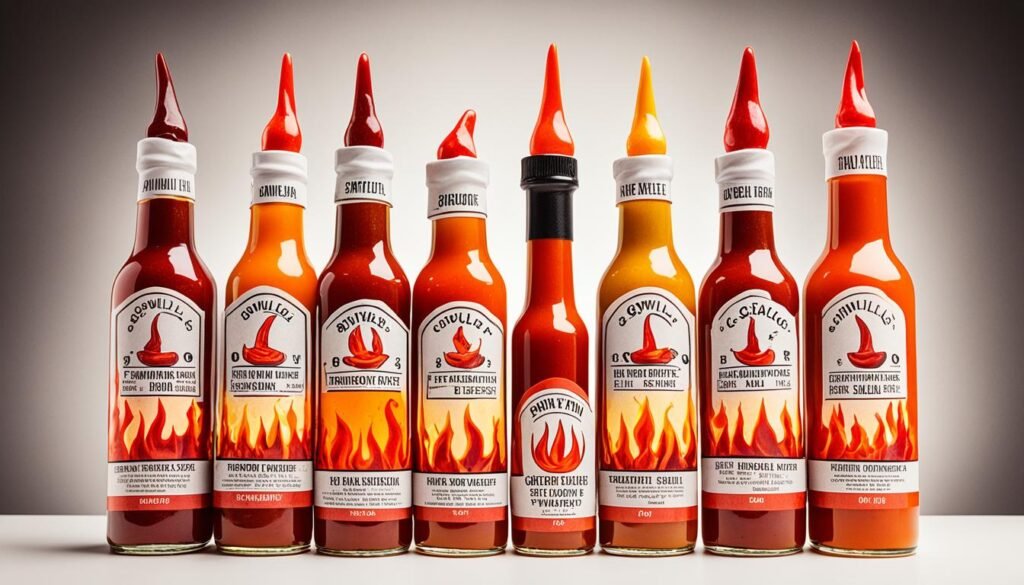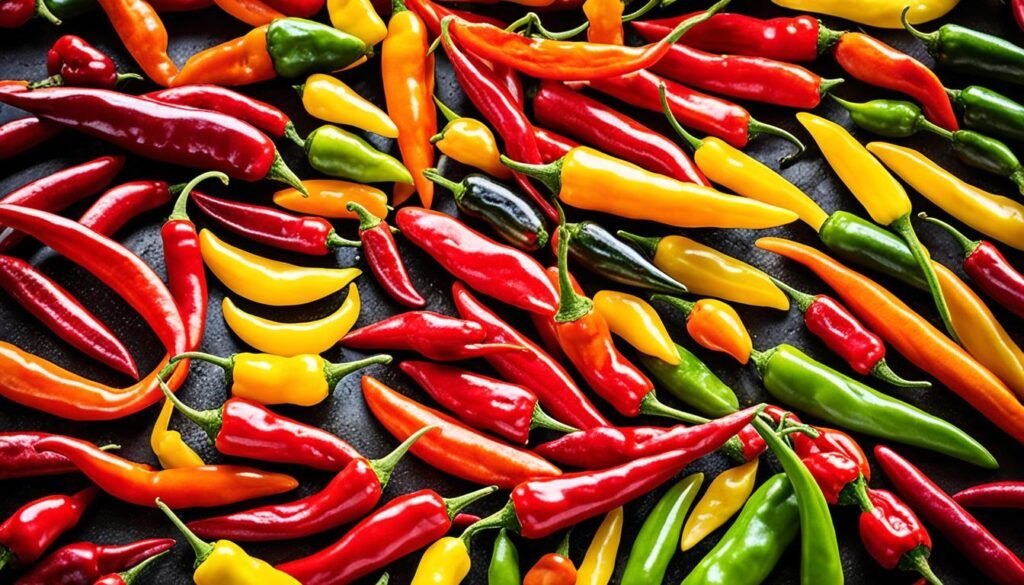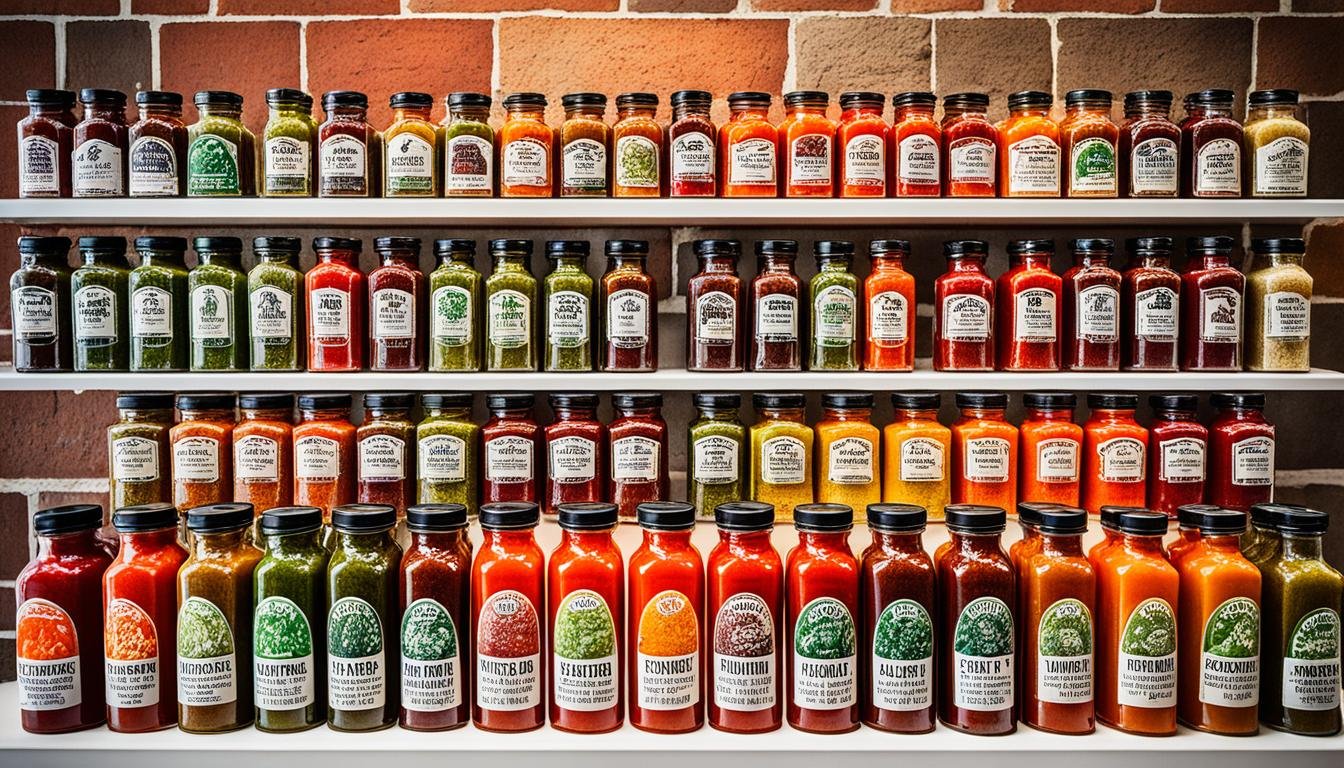Are you ready to ignite your taste buds? Join us on a thrilling journey through the world of hot sauces. Let’s uncover the secrets of SIANG JI ASIA SAUCE Types of Hot Sauce that turn your meals from plain to amazing. We’ll dive into the history and significance of these spicy add-ons. And we’ll look at the science with the Scoville scale and capsaicin levels. This Types of Hot Sauce guide will change how you see spice and flavor forever.
Key Takeaways
- Uncover the fascinating history and cultural significance of the types of hot sauce.
- Dive into the science behind the Scoville scale and capsaicin levels in hot sauces.
- Explore the diverse flavor profiles, from smoky to tangy, that define the types of hot sauce.
- Discover the unique cultivation and production methods that shape the types of hot sauce.
- Embark on a global journey to savor the regional varieties and popular hot sauce brands.
The Allure of Fiery Flavors: An Introduction to Types of Hot Sauce
Hot sauce isn’t just about heat; it’s about cultural stories and tastes that capture our imagination. These spicy sauces reflect the rich histories of various regions, adding more than just heat to their foods. They dive deep into the cultures, carrying symbolic meanings and starring in important celebrations. This part looks at what makes hot sauces tick, from the science behind their heat to the role capsicum plays. Let’s dive into the spicy world and see what makes each hot sauce unique.
Exploring the History and Cultural Significance of Types of Hot Sauce
Hot sauce’s story extends far into ancient times, where it meant more than just flavor. It was a way to honor the land and its harvest, and to connect spiritually. From the Aztec empires to the busy streets of Asia, its fiery taste has always been key in defining each region’s cuisine and culture.
Understanding the Scoville Scale and Capsaicin Levels of Types of Hot Sauce
The heat in hot sauces is measured by the Scoville scale. It shows how much capsaicin is in each type, affecting the spice level. Understanding this scale lets us appreciate the vast flavors and spicy levels out there. Whether you’re into mild or super hot sauces, knowing the Scoville scale can make your hot sauce adventure even more exciting.

“The beauty of types of hot sauce lies in their ability to transport us to distant lands and cultures, each with its own unique flavor and story to tell.”
Chili Pepper Varieties: The Building Blocks of Types of Hot Sauce
The flavor of hot sauce starts with the chili pepper varieties. They bring distinctive tastes, from smoky ancho to fiery habanero. Learn about chili peppers, their history, flavors, and how they’re turned into sauces that delight us.
Different chili pepper varieties come from unique places. Jalapeños, from central Mexico, provide moderate heat and great flavor. Chipotle, made by smoking jalapeños, adds a rich, earthy touch to sauces.
Habaneros, from Mexico’s Yucatán Peninsula, are very hot with fruity tastes. Bell peppers, on the other hand, are mild and sweet. They help balance the spice in some sauces.
| Chili Pepper Variety | Origin | Scoville Heat Unit (SHU) | Flavor Profile |
|---|---|---|---|
| Jalapeño | Central Mexico | 2,500 – 8,000 SHU | Moderate heat, versatile flavor |
| Chipotle (Smoked Jalapeño) | Central Mexico | 2,500 – 8,000 SHU | Rich, earthy, and slightly smoky |
| Habanero | Yucatán Peninsula, Mexico | 100,000 – 350,000 SHU | Intense heat, fruity and citrusy notes |
| Bell Pepper | Central America | 0 – 500 SHU | Sweet and mild, used to balance heat |
How chili peppers are grown and processed affects the final sauce. The soil, climate, and drying methods matter. This allows for a wide range of flavorful and hot hot sauces.

“The right chili pepper variety turns a hot sauce into a culinary journey.”
Embracing the Heat: A Deep Dive into the Types of Hot Sauce
Hot Sauce Flavor Profiles: From Smoky to Tangy of Types of Hot Sauce
There is a lot to explore in the world of hot sauce. Chipotle-based sauces bring a smoky and full flavor. Tropical versions offer a tangy and fruity taste. Each hot sauce type is a unique food adventure.
Chipotle peppers give sauces a comforting, complex taste. They include smoked jalapeños, garlic, and spices. Tropical kinds get their tang from mango or heat from habanero peppers. These sauces take your taste to sunny places.
Pepper Cultivation and Production Methods of Types of Hot Sauce
Hot sauce starts with unique peppers and how they are grown. The peppers, from Carolina Reaper to poblano, require special care to become flavorful and hot.
Pepper farmers and producers put a lot of effort into their work. They take care of everything from the environment to the way peppers are picked. After harvest, the peppers are fermented, aged, and blended. This creates the hot sauces we love.
| Pepper Variety | Scoville Heat Units | Flavor Profile | Common Uses in Types of Hot Sauce |
|---|---|---|---|
| Habanero | 100,000 – 350,000 SHU | Fruity, floral, and intensely hot | Tropical and Caribbean-inspired types of hot sauce |
| Jalapeño | 2,500 – 8,000 SHU | Slightly sweet, with a mild to moderate heat | Tex-Mex and Mexican-style types of hot sauce |
| Ghost Pepper | 855,000 – 1,041,427 SHU | Earthy, with a slow-building, intense heat | Specialty and extreme heat types of hot sauce |
| Chipotle | 2,500 – 8,000 SHU | Smoky, with a mild to moderate heat | Smoky and barbecue-inspired types of hot sauce |
Learning about how hot sauces are made shows the love and flavor in each bottle. From picking the peppers to the blending process, every step is a story of the land and tradition behind the sauce.
Popular Hot Sauce Brands and Varieties of Types of Hot Sauce
Discover the wide variety of hot sauce brands loved by spice fans worldwide. From the famous Cholula Hot Sauce to the zesty Tapatio, there’s a perfect type of hot sauce for everyone’s taste.
Mexican Hot Sauces: A Fiery Tradition of Types of Hot Sauce
Learn about the spicy world of Mexican hot sauces. They mix bold, smoky, and tangy flavors in iconic ways. Types of hot sauce like Valentina and Picante Poblano highlight Mexico’s rich and fiery culinary history.
Exploring Regional Flavors: Asian Hot Sauces of Types of Hot Sauce
Go on a taste adventure to Asia’s unique hot sauce varieties. Try the fiery Sriracha or the tangy Gochujang. These Asian hot sauces celebrate the continent’s diverse flavors and cooking traditions.

